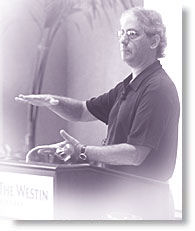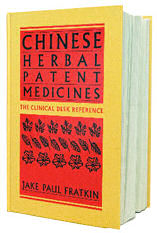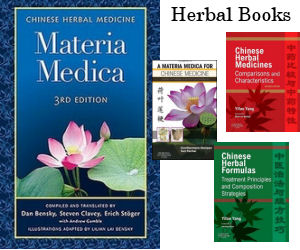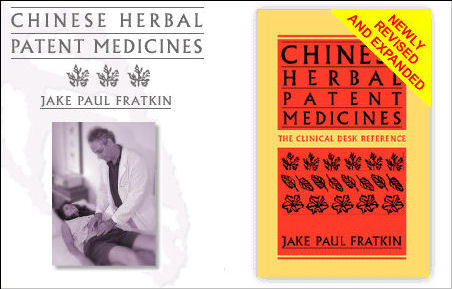Acupuncture & TCM Articles

Articles by Jake Paul Fratkin, OMD, LAc
Jake Fratkin, OMD, LAc, has been in the practice of Oriental medicine since 1978. Following undergraduate and graduate training at the University of Wisconsin in Chinese language and philosophy and pre-medicine, he pursued a seven-year apprenticeship in Japanese and Korean style acupuncture with Dr. Ineon Moon and a two-year apprenticeship in Chinese herbal medicine with Drs. Zhengan Guo and Pak-Leung Lau in Chicago. He also spent a year in Beijing hospitals interning in advanced herbal medicine, specializing in gastrointestinal and respiratory disorders, and pediatrics.  Dr. Fratkin is the author of several books, including Chinese Herbal Patent Medicines: The Clinical Desk Reference, and is the editor-organizer of Wu and Fischer's Practical Therapeutics of Traditional Chinese Medicine. In 1999, he was named the "Acupuncturist of the Year" by the American Association of Oriental Medicine.
Dr. Fratkin is the author of several books, including Chinese Herbal Patent Medicines: The Clinical Desk Reference, and is the editor-organizer of Wu and Fischer's Practical Therapeutics of Traditional Chinese Medicine. In 1999, he was named the "Acupuncturist of the Year" by the American Association of Oriental Medicine.
Chinese Herbal Patent Medicines: The Clinical Desk Reference
Hardback book, 1198 pages. This volume covers 1360 products, including 550 GMP level products and all of California FDB analysis on 505 products. Includes information on endagered animals, heavy metals, and pharmaceuticals. The text is organized into 12 groups, with a total of 109 chapters and includes material by Andrew Ellis, Subhuti Dharmananda, and Richard Ko. Over 80 pages of full-color photos (with English and Chinese cross-reference). Fully indexed.
The Potential Avian Flu Epidemic
Will a deadly avian flu pandemic spread across the globe, killing hundreds of thousands - if not millions - of people? From reading the newspapers or scanning the Internet, one would certainly think so.
At present, avian flu is confined to wild birds, domestic fowl and a few humans who have been in direct contact with them. As of Feb. 13, 2006, the World Health Organization (WHO) had confirmed 169 human cases in Indonesia, Vietnam, Thailand, Cambodia, China, Turkey and Iraq, causing 91 deaths.1 Since then, France and Nigeria also have reported cases. With this high death rate (53 percent), scientists and health agencies are concerned that a bird-to-human virus will mutate so as to allow human-to-human contagion, and that we might see a repeat of the horrific Spanish Flu of 1918.
The Spanish Flu of 1918 was responsible for 50 million deaths in a few short months.2 It was unique in that it had two stages of cross-species mutation, whereas, so far, the Avian Flu has had only one. Having that second Spanish Flu mutation allowed for human-to-human transmission, causing havoc to the world's population.

In 1918, the first source of a mutated virus was the cross-mingling of a pig virus and a bird virus in Chinese ponds where carp or other edible fish were cultivated for food. Farmers fertilized pond algae with pig dung (to provide food for the fish) while migrating geese or ducks also contaminated the ponds. A cross-species virus then mutated from geese and pig stool, was consumed by ducks and geese ingesting pond scum, and spread around the globe in the feces of migrating birds. The second mutation happened among closely confined and wounded soldiers in Europe at the end of World War I. When a normal influenza outbreak occurred in the clinics, trains and barracks, that virus was able to combine with a circulating mutated avian flu. This new virus proved highly infectious between humans and quickly transmitted around the world, causing millions of fatalities.
For the new Avian Flu to achieve this level of morbidity, it would need to mutate again. So far, all cases (except one) of Avian Flu have involved direct bird-to-human contagion, and the second mutation has not yet occurred.
The Experience of TCM in the Treatment of SARS
The question for practitioners of Chinese herbal medicine is how we might treat an initial acute stage of Avian Flu, and how to prevent infection for those who have had contact with sick individuals. This is a difficult question, because we don't know what such an infection will look like or how virulent it will be. For the few people who have had contact with Avian Flu, the virus seems to injure the epithelium of lung cells, allowing rupturing and/or a perfusion of fluid that essentially causes the patient to suffocate to death in a very short time, often within a week.
The Spanish Flu of 1918 gives us an indication of how horrific and rapid such an epidemic can be. Many victims died within one to three days from onset, technically of pneumonia. Its death rate was only 5 percent to 10 percent, but because it infected between 30 percent and 50 percent of the world's population, huge numbers of deaths resulted. The SARS (Sudden Acute Respiratory Syndrome) epidemic of 2003 had a 9 percent death rate, but only 8,500 people were infected enough to be hospitalized. Although the SARS epidemic was not nearly as powerful or virulent as Spanish Flu, to some extent the symptom picture and progression were similar. The TCM response to SARS in China and Hong Kong offers TCM practitioners real insight into management of an epidemic or pandemic flu.
Unlike Spanish Flu, SARS took between two and six weeks to cause death. Using the insights of experienced TCM doctors, the Chinese government publicized herbal approaches to treat various stages of the illness, and how to treat healthy people in contact with those who were sick. In Hong Kong, where TCM has been forbidden in the hospital system since 1945, many Western doctors saw the ineffectiveness of the Western response and actually promoted the use of TCM herbal formulas for their own health workers, as well as the general public.
Wen Bing Prescriptions
When SARS hit China and Hong Kong, TCM doctors were quick to identify patterns and offer prescriptions. From classical wen bing theory (warm diseases), three stages were observed: initial, acute and recovery. Key prescriptions were recommended to the general public that could be obtained as patent medicines, for those unable to utilize TCM practitioners.
For the initial stage, or as prevention, three formulas were recommended. For wind-warmth in the wei level, with fever and chills, yin qiao san was recommended. For warm toxin in the upper burner, with signs of sore throat and fever, the formula was pu ji xiao du yin. For summer heat attacking the lung and wei level, with signs of lung fire cough, they recommended sang ju yin.3
For the acute stage, the following formulas were recommended. For spring-warmth, with excess heat in the stomach causing high fever, bai hu tang. For summer heat-warmth with stagnation of damp-heat, causing fever with heaviness, nausea and diarrhea, gan lu xiao du yin. These formulas should be familiar to herbalists.
For the third, critical stage, custom prescriptions were required. For wind-warmth, ying level with yin fire, qing ying tang was recommended. For spring-warmth, heat in the ying or blood level, use qing wen bai du yin. The composition of these two formulas is as follows:
Qing Ying Tang (Wu Jutong, 1798)
shui niu jiao (cornu bubali);* xuan shen (radix scrophulariae ningpoensis), sheng di huang (radix rehmanniae glutinosae), mai men dong (tuber ophiopogonis japonici), jin yin hua (flos lonicerae japonicae), lian qiao (fructus forsythiae suspensae), huang lian (rhizoma coptidis), dan zhu ye (herba lophatheri gracilis), dan shen (radix salviae miltiorrhizae)
* Here, water buffalo horn has been substituted for xi jiao (cornu rhinoceri).
Qing Wen Bai Du Yin (Yu Shiyu, 1794)
shi gao (gypsum), zhi mu (radix anemarrhenae asphodeloidis), gan cao (radix glycyrrhizae uralensis), dan zhu ye, xi jiao, sheng di huang, mu dan pi (cortex moutan radicis), chi shao (radix paeoniae rubrae), xuan shen, huang lian (rhizoma coptidis), huang qin (radix scutellariae), zhi zi (fructus gardeniae jasminoidis), lian qiao, jie geng (radix platycodi grandiflori)
In addition to these formulas, the Chinese Ministry of Health and the World Health Organization made numerous recommendations of herbal combinations and formulas that were distributed through the mass media.4
In the management of the SARS crisis, an interesting trend emerged - that of reinforcing classical formulas with the addition of herbs with strong antiviral effects. Usually classified under the "clear heat, resolve toxin" category (qing re jie du), many of these herbs were discovered during the 1950s. At that time, the Chinese government conducted broad health campaigns that encouraged rural villages to share any knowledge of local herbs with strong medicinal effects. Since that time, relatively obscure herbs have come into predominance for their effectiveness against viruses; many were also used to treat SARS. The following herbs have shown strong anti-flu virus effect, and were sought after and used by many during the epidemic: chuan xin lian (herba andrographitis paniculatae), she gan (rhizoma belamcandae chinensis), guan zhong (rhizoma dryopteris crassirhizomae), shan zhi ma (radix helicteris), yu xing cao (herba cum radice houttuyniae cordatae), mao dong qing (radix ilicis pubescendis), qi ye yi zhi hua (rhizoma paridis polyphyllae), bai jiang cao (herba cum radice patriniae), hu zhang (radix et rhizoma polygoni cuspidati), ma bian cao (herba verbanae) and zi hua di ding (herba cum radice violae yedoensis).
In addition, two herbs from Taiwan that had been introduced into mainland China in the late 1980s were recognized for their strong antiviral properties. These are san cha ku (radix et ramus evodiae leptae) and gang mei gen (radix ilicis asprellae). These two herbs comprise 56 percent of the extraordinary patent medicine gan mao ling, used for the common cold.
The Hong Kong Study
In terms of scientific validation of the efficacy of Chinese herbs, there is at least one study that favorably endorsed Chinese herbs in the treatment and prevention of SARS. Due to the high infection rate of SARS among Hong Kong health workers (20 percent of hospitalized cases and six deaths), the Institute of Chinese Medicine, Hong Kong authorized a rapid study to see if Chinese herbs could reduce infection rates or reduce the severity of the illness.5
Hospital health care workers taking the herbal decoction were monitored not only for hospitalization, but also for severity and diversity of symptoms if they became sick, but without needing hospitalization. None of the 1,063 research subjects who used the herbal supplement contracted SARS or needed hospitalization. Their symptoms and duration of illness were considered significantly less than those seen in a control group of health workers who agreed not to take any Chinese herbs during this period. The results were so significant that officials at the Hong Kong Chinese University immediately made the formula available to 3,160 health care workers. None of these workers needed to be hospitalized. The Hong Kong government also made the formula, in water-extracted granule form, available as 40,000 packets to the general public.6
The formula chosen was sang ju yin, a wen bing formula created by Wu Jutang in 1798, with additions. The original sang ju yin formula uses sang ye (folium mori albae), ju hua (flos chrysanthemi morifolii), lian qiao, bo he (herba menthae haplocalycis), jie geng (radix platycodi grandiflori), xing ren (semen pruni armeniacae), lu gen (rhizoma phragmitis communis) and gan cao. The adjusted formula added da qing ye (folium isatidis seu baphicacanthi), huang qin and huang qi (astragali membranaceus).
Conclusion
It's highly unlikely that a double mutated Avian Flu with human-to-human contagion will occur. The British Medical Journal recently featured an editorial on the bird flu which stated, "The lack of sustained human-to-human transmission suggests that this AH5N1 avian virus does not currently have the capacity to cause a human pandemic."7
If it does, its severity will challenge the resources of both Western medicine and Chinese herbs in providing an effective control. However, in the advent of less severe SARS-type influenza (and in the case of "regular" influenza), we have significant resources for treatment in both prepared Chinese herbal products and in individually concocted formulas as decoctions, powered extracts or alcohol extracts. Presently for flu, as a first resort, I would recommend making a formula or using herbal products that address the early presentations, such as yin qiao san, pu ji xiao du san or sang ju yin, combined with a strong antiviral herbal product such as gan mao ling, zhong gan ling or chuan xin lian.8
For more thorough overviews of Avian Flu, please see www.who.int/csr/disease/avian_influenza/avian_faqs/en/index.html#whyso and www.synapses.co.uk/science/fluvirus.html. For a valuable overview of the SARS epidemic of 2003, see Subhuti Dharmanada's article "SARS and Chinese Medicine" at www.itmonline.org/arts/sars.htm.
References
1 http://news.bbc.co.uk/2/hi/health/3422839.stm.
2 Wikepedia, http://en.wikipedia.org/wiki/Spanish_flu.
3 See pages 6-7, "TCM Anti-Viral Therapy: Using Wen Bing Theory in the Treatment of Modern Epidemics," by Jake Paul Fratkin. http://drjake fratkin.com/pdf/WenBing-Virus-1.pdf.
4 Fifteen of the recommended formulas are available in my workshop notes, cited above. See pages 7-12.
5 Leung PC, Lau TF, Cheng KF, Lam CWK. Report A: A Herbal Formula for the Prevention of Transmission of SARS During the SARS Epidemic in Hong Kong Special Administrative Region - A Prospective Cohort Study. http://whqlibdoc.who.int/publications/ 2004/9241546433_reportA.pdf.
6 The details are also summarized on my notes, page 10. See "TCM Anti-Viral Therapy: Using Wen Bing Theory in the Treatment of Modern Epidemics." http://drjakefratkin.com/pdf/WenBing-Virus-1.pdf.
7 British Medical Journal, Oct. 29, 2005; 331(7523): 975-976. Quoted at www.mercola.com/2005/nov/15/
finally_medical_journal_admits_the_truth_about_bird_flu.htm.
8 These products are described in my book, Chinese Herbal Patent Medicine: The Clinical Desk Reference, Shya Publications, 2001.
 
|
